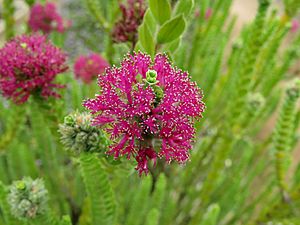Regelia facts for kids
Quick facts for kids Regelia |
|
|---|---|
 |
|
| Regelia megacephala flowers at Royal Botanic Gardens, Cranbourne | |
| Scientific classification |
|
| Kingdom: | Plantae |
| Clade: | Tracheophytes |
| Clade: | Angiosperms |
| Clade: | Eudicots |
| Clade: | Rosids |
| Order: | Myrtales |
| Family: | Myrtaceae |
| Subfamily: | Myrtoideae |
| Tribe: | Melaleuceae |
| Genus: | Regelia Schauer |
| Species | |
|
See text |
|
Regelia is a group of flowering plants. They belong to the Myrtaceae family, which also includes plants like eucalyptus. These plants are found only in the south-west part of Western Australia.
There are five different kinds, or species, of Regelia. They are small, evergreen shrubs with tiny leaves. Their flowers grow in bunches at the ends of branches. These branches keep growing even after the flowers bloom. Another plant, once called Regelia punicea, is now known as Melaleuca punicea. It grows in Kakadu National Park in the Northern Territory.
Contents
What Regelia Plants Look Like
Regelia plants are woody shrubs that stay green all year. They can grow from about 1 to 6 meters (3 to 20 feet) tall. Their leaves are small and grow in pairs or in a spiral shape. These leaves are special because they contain essential oils.
The flowers are usually pinkish-purple, but sometimes they can be red. They grow in heads, or clusters, at the end of branches. Each flower has 5 sepals (small leaf-like parts that protect the bud), 5 petals, and many stamens. Stamens are the parts that make pollen. The stamens are grouped into 5 bundles around the flower's edge.
Regelia plants are similar to other plants like Melaleuca and Calothamnus. However, they are different in how their anthers (the part of the stamen that holds pollen) are attached. In Regelia, the anthers are attached at the bottom and open through small holes to release pollen. Their fruits are woody capsules. These capsules have three sections, and each section can hold up to two seeds that can grow.
Naming Regelia Plants
The name Regelia was first officially used in 1843. It was described by a scientist named J.C. Schauer. The first species he named was Regelia ciliata.
The name Regelia was chosen to honor a German gardener and botanist named Eduard August von Regel.
Where Regelia Plants Grow
All five types of Regelia plants are found in the South West Botanical Province of Western Australia. They like to grow in sand or sandy soil. You can often find them near areas that get wet during the winter.
Protecting Regelia Plants
Two species of Regelia, Regelia cymbifolia and Regelia megacephala, are considered "Priority Four" by the Western Australian government. This means they are rare or almost threatened. They need to be watched and protected to make sure they don't disappear.
Types of Regelia Species
Currently, there are five types of Regelia plants that scientists recognize:
- Regelia ciliata Schauer
- Regelia cymbifolia (Diels) C.A.Gardner
- Regelia inops (Schauer) Schauer
- Regelia megacephala C.A.Gardner
- Regelia velutina (Turcz.) C.A.Gardner - also known as Barrens regelia.
A sixth species, Regelia punicea, had a bit of a name journey! It was first named Melaleuca punicea in 1984. Then it was called Regelia punicea, then Petraeomyrtus punicea. Finally, in 2013, scientists decided it was best to call it Melaleuca punicea again, based on new information from its DNA.
See also
 In Spanish: Regelia para niños
In Spanish: Regelia para niños

